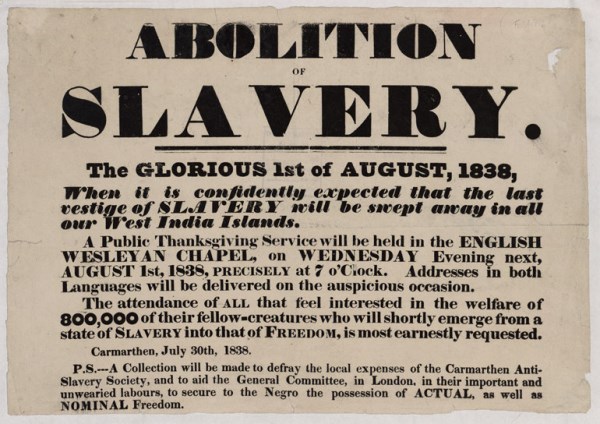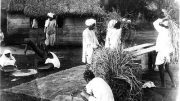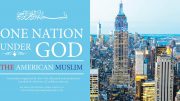The Slavery Abolition Act 1833 was an 1833 Act of the Parliament of the United Kingdom abolishing slavery throughout most of the British Empire (with the notable exceptions “of the Territories in the Possession of the East India Company,” the “Island of Ceylon,” and “the Island of Saint Helena”).
Slavery was officially abolished in most of the British Empire on 1 August 1834. In practical terms, however, only slaves below the age of six were freed, as all slaves over the age of six were re-designated as “apprentices”.
“Apprenticeships”
Apprentices would continue to serve their former owners for a period of time after the abolition of slavery, though the length of time they served depended on which of three classes of apprentice they were. The first class of apprentices were former slaves who “in their State of Slavery were usually employed in Agriculture, or in the Manufacture of Colonial Produce or otherwise, upon Lands belonging to their Owners. The second class of apprentices were former slaves who “in their State of Slavery were usually employed in Agriculture, or in the Manufacture of Colonial Produce or otherwise, upon Lands not belonging to their Owners”. The third class of apprentices was composed of all former slaves “not included within either of the Two preceding Classes”. Apprentices within the third class were released from their apprenticeships on 1 August 1838. The remaining apprentices within the first and second classes were released from their apprenticeships on 1 August 1840.
Slave Owners Compensated
The Act also included the right of compensation for slave-owners who would be losing their property. The amount of money to be spent on the compensation claims was set at “the Sum of Twenty Millions Pounds Sterling”. Under the terms of the Act the British government raised £20 million to pay out in compensation for the loss of the slaves as business assets to the registered owners of the freed slaves. The names listed in the returns for slave compensation show that ownership was spread over many hundreds of British families,[15] many of them of high social standing. For example, Henry Phillpotts (then the Bishop of Exeter), in a partnership with three business colleagues, received £12,700 for 665 slaves. The majority of men and women who were awarded compensation under the 1833 Abolition Act are listed in a Parliamentary Return, entitled Slavery Abolition Act, which is an account of all moneys awarded by the Commissioners of Slave Compensation in the Parliamentary Papers 1837-8 Vol. 48. In all, the government paid out over 40,000 separate awards. The £20 million fund was 40% of the government’s total annual expenditure.
Trinidad First To Completely Abolish Slavery
On 1 August 1834, an unarmed group of mainly elderly people being addressed by the Governor at Government House in Port of Spain, Trinidad, about the new laws, began chanting: “Pas de six ans. Point de six ans” (“Not six years. No six years”), drowning out the voice of the Governor. Peaceful protests continued until a resolution to abolish apprenticeship was passed and de facto freedom was achieved. Full emancipation for all was legally granted ahead of schedule on 1 August 1838, making Trinidad the first British colony with slaves to completely abolish slavery.
African Muslims Rebelled Against Slavery – A Brief Chronology
-
1492 African Muslims from Granada and Guinea landed in the New World with Columbus 1500-Berbers , Wolofs and Mandingoes sold as slaves in Mexico.
-
1503-Spanish report runaway slaves/Maroons spreading Islam among the slaves
-
1516-17-Ferdinand ‘the Catholic’, allowed Muslims to openly practice Islam in the New World.
-
1518-Ferdinand was relieved of his duties by Cardinal Cisnetes, because he allowed “Hebrews and Muslims” to openly hold their rites.
-
1518-African Muslims and non -Muslims begin to form Maroon communities in Haiti.
-
1522 -On Christmas Day, 1522, 20 enslaved Muslim Africans used machetes to attack their Christian masters on the island of Hispaniola, then governed by the son of Christopher Columbus. The assailants, condemned to the grinding toil of a Caribbean sugar plantation, killed several Spanish and freed a dozen enslaved Native Americans in what was the first recorded slave revolt in the New World. The uprising was quickly suppressed, but it prompted the newly crowned Charles V of Spain to exclude from the Americas “slaves suspected of Islamic leanings.” He blamed the revolt on their radical ideology rather than the harsh realities of living a life of slavery.
-
1532-Wolof Muslims lead slave rebellion among Carib Indians.
-
1532-Wolof barred from Puerto Rico for spreading jihad.
-
1550-Spanish began to buy slaves from areas they believed were free of Muslims.
-
1500’s- Luis Solan a mulato and Lepe de la Pen, a Moor from Guadalajua were convicted of spreading Islam in Cuzco.
-
1533-Spanish ban Wolof in West Indies.
-
1537-Muslims from Africa and Spain stage a rebellion/jihad in Mexico
-
1539-King of Spain bans the sons and grandsons of Jews and Moors burned at the stake in the West Indies and Mexico.
-
1543-Charles V ratified the decree and ordered the expulsion of all KNOWN Muslims from New Spain.
-
1548-Muslims maroons stage rebellion in Honduras.
-
1565-Wolofs were ordered out of Chile for spreading Islam.
-
1578- Muslims from Philippines are reported spreading Islam among Indians in Mexico.
-
1578-Berbers and Moriscos (Muslims) were barred from Mexico.
-
1578- Muslims from Granada are reported teaching Islam among Mexican Indians.
-
1600’s Muslim slaves were being sold in Buenos Aires and Venezuela, where they are reported to have been workers in the Cocorole mines.
-
1620-Spanish begin importing Mandigoes as slaves.
-
1620-Spanish begin to torture Mandingo slaves because they refuse to accept Christianity.
-
1753-1757-Machandal a Muslim maroon from Senegal leds a jihad in Haiti.
-
1700″s- Arabi, the Muslim led Bush Blacks in Suriname.
-
1800’s- Muslims reported living in Jamaica, Santo Domingo, Venezuela, Trinidad, Haiti, and Brazil.
-
1814-Muslim re-captives forced to serve in Royal Navy.
-
1811-1831-Mandingo Society actively liberates fellow Muslim slaves from bondage in Trinidad.
-
1836- Muslim members of the 3rd West India Regiment and their families are returned to Africa by the British.
-
1836-Supreme Imam of Trinidad Jonas Bath died
- 1910-There were 100,000 Muslims living in Brazil.
Source: Rafael A.G. Bazan, Muslim immigration to Spanish America, Muslim World, (July,1966), pp.173-187. Winters,Clyde Ahmad, “Islam in Early North and South America”, Al-Ittihad, (November 1977a) .
Winters,Clyde Ahmad, “Islam in Early North and South America”, Al-Ittihad, (November 1977) .





Be the first to comment on "Freedom Come. African Muslim Slaves and The Abolition of Slavery"